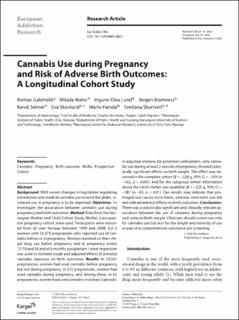| dc.description.abstract | Background: With recent changes in legislation regulating recreational and medical cannabis use around the globe, increased use in pregnancy is to be expected. Objectives: To investigate the association between cannabis use during pregnancy and birth outcomes. Method: Data from the Norwegian Mother and Child Cohort Study (MoBa), a prospective pregnancy cohort, were used. Participants were recruited from all over Norway between 1999 and 2008: 9,312 women with 10,373 pregnancies who reported use of cannabis before or in pregnancy. Women reported on their illegal drug use before pregnancy and at pregnancy weeks 17/18 and 30 and at 6 months postpartum. Linear regression was used to estimate crude and adjusted effects of prenatal cannabis exposure on birth outcomes. Results: In 10,101 pregnancies, women had used cannabis before pregnancy but not during pregnancy. In 272 pregnancies, women had used cannabis during pregnancy, and among these, in 63 pregnancies, women had used cannabis in at least 2 periods. In adjusted analyses for potential confounders, only cannabis use during at least 2 periods of pregnancy showed statistically significant effects on birth weight. The effect was observed in the complete cohort (B = −228 g, 95% CI = −354 to −102, p < 0.001) and for the subgroup where information about the child’s father was available (B = −225 g, 95% CI = −387 to −63, p = 0.01). Our results may indicate that prolonged use causes more harm, whereas short-term use did not indicate adverse effects on birth outcomes. Conclusions: There was a statistically significant and clinically relevant association between the use of cannabis during pregnancy and reduced birth weight. Clinicians should screen not only for cannabis use but also for the length and intensity of use as part of a comprehensive substance use screening | en_US |

